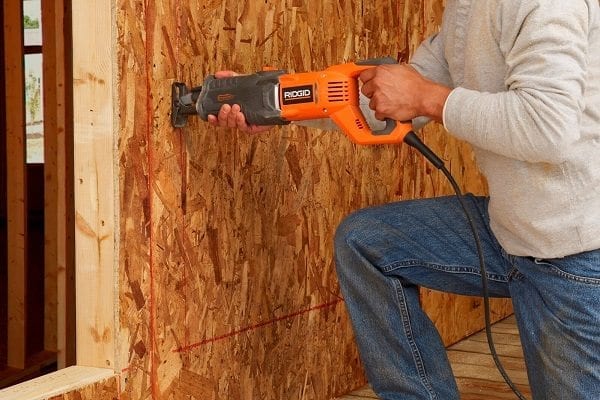
7 safety rules for using a reciprocating saw
Reciprocating saws are powerful tools by nature, designed to cut through a variety of materials and proper precautions are required to use a reciprocating saw safely. The Power Tool Institute offers these safety rules for using a reciprocating saw.
- Extension cords. The power cords that come with reciprocating saws have limited length, so it’s not unusual to extend the reach of the tool by plugging it into an extension cord. If you do:
- Choose a cord with sufficient wire gauge and length to handle the amps of the tool. You’ll find the tool’s amps on its nameplate.
- Replace a cord that is damaged. Cords can fray, kink and break. When they do, they create both a fire hazard and the risk of electrical shock.
- If you’re working outdoors, insist on an extension cord rated for outdoor use. Those are marked with the letters “W” or “W-A.”
- Plug three-pronged grounding plugs into three-pronged outlets. Never cut the third prong off of a plug to force it into a two-pronged outlet.
- When talking about safety rules for using a reciprocating saw, following manufacturer’s instructions is critical. Experienced contractors rarely read the owner’s manual and safety instructions that come with the tool. But taking a few minutes to review the rules could save you from injury and your tool from premature death
- Personal safety. When using any power tool, take a few precautions to keep yourself safe and prevent mishaps. Here are three safety rules for using a reciprocating saw that should be non-negotiable:
- Do not operate power tools when you’re over-tired. It’s important to stay sharp and alert so you can watch what you are doing.
- Never use power tools if you have been drinking alcohol or using recreational drugs. Stay away from the reciprocating saw if you are taking a prescription medication with the potential side effect of drowsiness.
- Dress for the job. Loose clothing, jewelry and even long hair can get in the saw’s moving parts and trap you as you operate the tool. Wear non-skid shoes, safety goggles, a dust mask and a hard hat. For some jobs, you might need hearing protection.
- Maintenance. Before you power the saw on, inspect it for clean, dry handles. Greasy or oily handles can cause your hand to slip during operation. Also, don’t use the tool if:
- The power switch doesn’t turn it on and off.
- Any parts appear to be misaligned or broken.
- Blades and bits are not sharp and clean. Metal chips or sawdust on a blade can cause it to malfunction.
- It has been cleaned with gasoline, ammonia or another cleaning agent not recommended by the manufacturer.
- It hasn’t been serviced by a qualified repair technician. Don’t try to repair it yourself.
- When talking about precautions for using a reciprocating saw, don’t forget common sense. Turn the tool off and unplug it before you insert or remove a battery pack, and turn it off when you’re not using it. Also, let the saw stop completely—it’s not immediate–and cool off after you turn it off. Reciprocating saw blades can get quite hot during use and can burn you if you touch them too soon.
- Tool accessories. Don’t mix and match accessories designed for other tools when using your reciprocating saw. And use the right tool for the job; don’t force your saw into uses it wasn’t designed for. Likewise, replace worn-out or defective tool parts with identical pieces; don’t improvise.
- Operation. Take care to:
- Clamp the work piece down so it is secure and won’t move during the cut.
- Avoid cutting anything that you have reach up for.
- Move the power cord out of your way so you don’t cut through it, trip over it or pull it out of the electrical socket.
- Hold the reciprocating saw with both hands.
Hold the saw’s shoe against the work piece for maximum control—and to prevent the blade from breaking.

